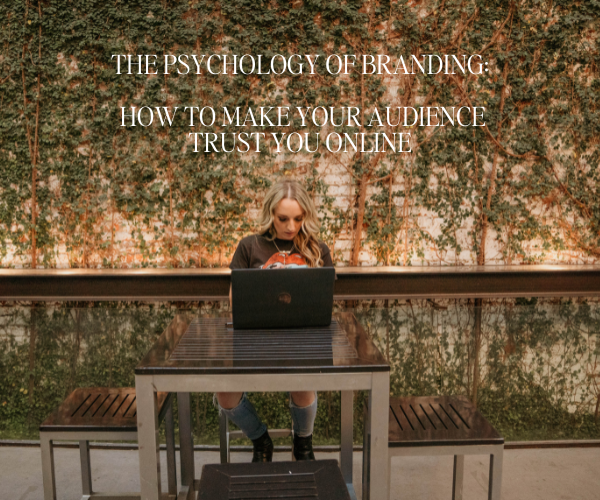Babe, let’s get real for a second: people don’t buy from businesses they don’t trust. Period. You can have the prettiest color palette, a perfectly curated feed, and the fanciest fonts, but if your audience doesn’t believe in you, they’re not pulling out their wallets. They’re scrolling right past. Here’s the kicker: trust isn’t built by “looking professional” alone. It’s built by how you make people feel. And that’s where the psychology of branding comes in.

First Impressions Matter (And the Science Backs It Up)
You’ve probably heard the saying: “You never get a second chance to make a first impression.” Well, science says it’s true.
Research shows people form an opinion about you within the first 7 seconds. Seven. That’s faster than it takes you to decide what song to skip on Spotify.
Now, if your brand feels DIY, inconsistent, or outdated, you’re unintentionally telling your audience, “I’m not ready for your trust yet.” Even if your services are fire, the perception gap kills conversions.
Here’s where psychology meets branding: our brains are wired to seek out credibility cues. Clean visuals, aligned messaging, and cohesive design all signal authority and safety. And when people feel safe, they buy.
Truth bomb: Your brand visuals aren’t just “aesthetic.” They’re trust builders.
Consistency Creates Credibility
Let’s talk about one of the most underrated principles of the psychology of branding: cognitive fluency.
Translation? Humans trust what feels familiar. When your brand is consistent same tone, same vibe, same look, your audience doesn’t have to work to understand you. Their brain says, “Oh, I know this person. They’re reliable.”
But when you’re all over the place? Switching colors every season, using 12 different Canva fonts, talking like a different person in every caption? You’re creating friction. And friction breaks trust.
Your audience doesn’t consciously think, “This brand feels inconsistent, so I don’t trust them.” But subconsciously? Their brain hits pause. And paused people don’t purchase.
Hot take: Consistency is sexy.
Stories Build Emotional Connection
Here’s where the psychology of branding gets fun: mirror neurons.
These are the parts of our brain that light up when we hear a story. It’s why you cry during movies even though you know it’s fake. Our brains are wired to connect through story.
So, when you share real, authentic stories in your branding like how you started, what you believe, and what you’ve learned, you’re not just “humanizing your brand.” You’re building empathy and trust.
Stories don’t need to be epic. You don’t need to trauma dump or share your deepest secrets to connect. The “messy middle” moments (like posting about the chaos of prepping for a launch or the behind-the-scenes bloopers of your content day) are what make you relatable.
Pro tip: Audit your last 3 posts. Were you telling a story…or just filling space?
Authority Is Built, Not Claimed
Have you ever heard of authority bias? It’s the tendency we all have to trust and follow people we perceive as experts.
But here’s the thing, authority isn’t built by slapping “CEO” in your Instagram bio. Authority is built through receipts. Testimonials. Case studies. Podcast guest spots. Content that educates and empowers.
Think about it: when was the last time you trusted a “business coach” just because their bio said “7-figure mentor”? Probably never. But when someone shows you results, client transformations, strategies that work, thought leadership you’re sold.
Here’s the difference: Wannabe experts claim authority. Real experts demonstrate it.
And this is where branding psychology is powerful: showcasing authority in your content builds trust faster than any viral reel ever could.
Authenticity Wins Every Time
Fake it ‘til you make it culture.
Audiences are tired of perfectly polished brands that feel like robots and “highlight reels” with zero realness.
Psychology proves it too: trust bias says we believe people who feel real. That doesn’t mean you should overshare or dump your unfiltered life online (please don’t). It means showing up authentically with discernment.
Example: Share the behind-the-scenes of your photoshoot, even if the tripod fell over twice. Share your excitement about a client win. Share the lesson you learned from a failed launch.
Authenticity isn’t about exposure, it’s about alignment. And aligned brands? They’re magnetic.
The Big Picture: Branding That Builds Trust
Here’s what I want you to remember: branding isn’t just fonts, colors, or aesthetics. Branding is psychology.
When you understand how people build trust online and then design your brand to work with that psychology instead of against it you go from invisible to irresistible.
- First impressions make you look credible.
- Consistency makes you feel reliable.
- Stories create connection.
- Authority builds respect.
- Authenticity seals the deal.
That’s the formula for trust. That’s the psychology of branding in action.
Final Word: Your Brand Deserves to Be Trusted
Babe, you’ve worked too hard to let your brand feel like an afterthought. You don’t need to scream louder than the algorithm. You need a brand rooted in psychology, strategy, and authenticity the kind that doesn’t just look good, but makes people believe in you.
Because when your audience trusts you? Sales stop feeling like pulling teeth. Referrals flow. Opportunities multiply. Your brand goes from background noise to unforgettable.
Ready to build a brand that your audience can’t help but trust? Let’s talk. Book your clarity call today and let’s create a brand that sells, not just scrolls.

Read the Comments +